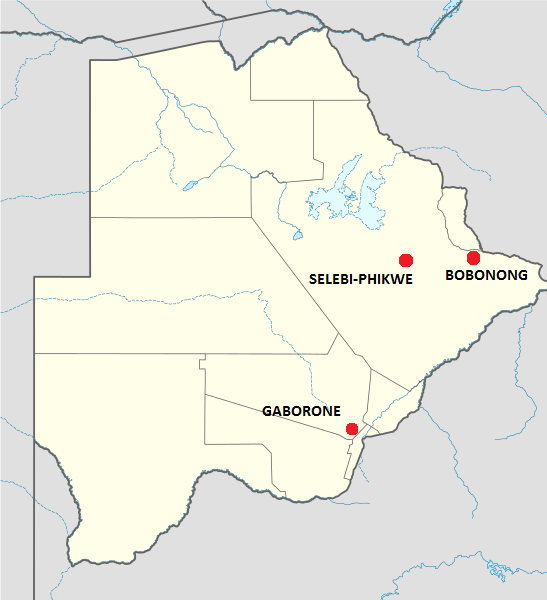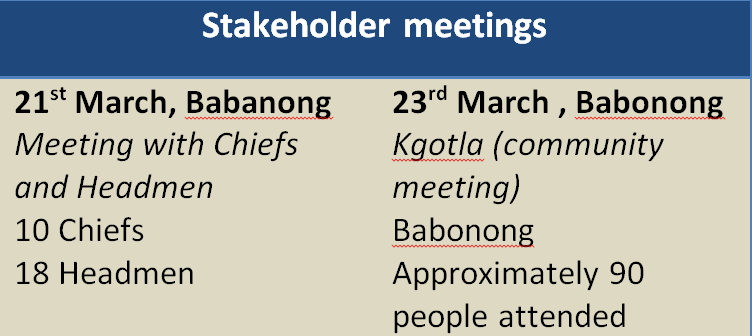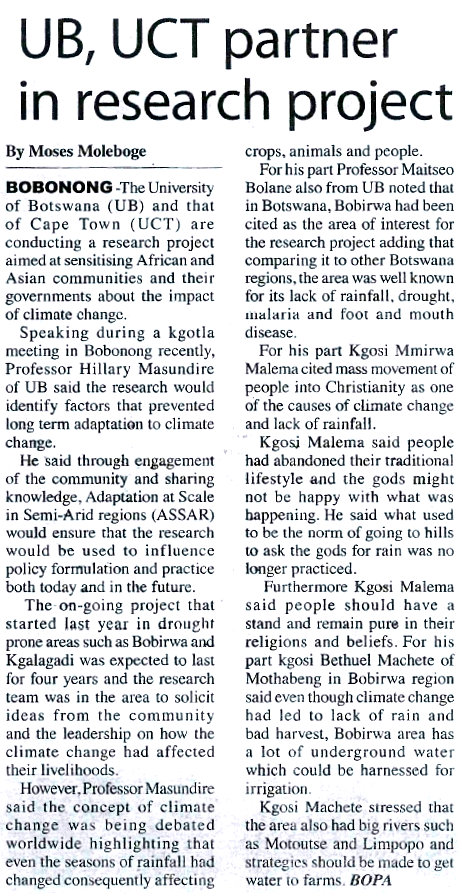Field Trip: Bobirwa Sub-District, Botswana

Written by Katrine Claassens with contributions by Dian Spear, Hilary Masundire, Maitseo M Bolaane and Nelly Raditloaneng
The Intergovernmental Panel on Climate Change has predicted that climate change will result in increasing aridity in southern Africa. This prediction has indeed been observed by people living in Bobirwa region, where in recent years droughts, as well as other factors, have increased the vulnerability of these rural communities.
In January, 2015, ASSAR’s Southern African team travelled to the Bobirwa sub-district of Botswana to host several stakeholder engagement events. The team was particularly interested to learn about the ways that people in the Limpopo River basin are vulnerable to both climate- and development-related hazards and risks.

Image: Area Map featuring Bobonong and Selebi-Phikwe of the Bobirwa sub-district of Botswana
Identifying vulnerabilities: learning from stakeholder dialogues
The team consulted with government officials, traditional leaders and local communities to better understand local perceptions of climate change and its causes, local responses to climate changes, and the support and solutions needed to build and improve local resilience.

Image: ASSAR team with chiefs
Stakeholders repeatedly said they were noticing that less rain was falling, rains were arriving at different times and droughts were lasting longer. In a region where livelihoods depend on agriculture, such changes to the hydrological system pose pervasive and significant threats.

Apart from inadequate and unpredictable rainfall, participants identified other critical issues that affected their resilience. Some were environmental, such as reductions in natural resources: less food, water, grass, timber, and a drop in the Mopane worm population - an important local source of protein. Stakeholders also said that they had noticed changes in species ranges and distributions, and that permanent rivers no longer flowed all year round. Concerns were also raised about foot-and-mouth disease which reduced prospects for farmers. Other issues affecting local resilience are socio-economic, including high rates of HIV/AIDS, increasing rates of teenage pregnancies, lack of parental care and the unexpected effects of Ipelegeng - a governmental welfare system that people believe has led to reduced self-reliance. In an area with poor infrastructure, few services and limited job prospects, out-migration to cities was also seen as problematic. Many also voiced concern over the high turnover rate of government officials, and the common application of vulnerability solutions that are short-sighted, inappropriate and ineffective.
Local interpretation of vulnerabilities
These climatic changes and vulnerabilities were strongly understood in the context of traditional and Christian belief systems. For some, climate change was considered as a punishment by the ancestors for the shift to Christianity and the abandonment of traditional beliefs and rituals. Others cited dual religious practices – traditional ancestral worship parallel with Christianity – as being the cause of God’s punishment. Also blamed was the “arrogance and cleverness of humans” that has led to harmful dam construction and emissions from mines and cars.

Image: Roadside Vendors
Learning from stakeholder dialogues: adaptation and solutions
These first meetings with local stakeholders were also an opportunity to learn about local adaptive measures and gain insights into possible sustainable solutions. Stakeholders voiced the importance of practices that incorporated indigenous knowledge and culture, stressing that society elders had valuable information about adaptation measures. Conservation agriculture and the use of local breeds of drought-resistant cattle and crops were seen as potential adaptation options. Importantly, stakeholders were interested in developing and implementing adaptation strategies but they felt that they needed more information to do so effectively. They expected that ASSAR could provide them with this kind of information.

Image: Meeting with Kgotla (community meeting)
Ways forward
This early engagement with stakeholders provided insight into the possible challenges and ways ahead for ASSAR in southern Africa. The level of engagement and willingness from people was encouraging and indicated that ASSAR’s participatory scenario planning processes have promise in Botswana. The ASSAR team learnt that to be effective, adaptation solutions need to take into account the impacts of climate variability and climatic extremes as much and as well as the pervasive local development challenges. It’s also clear that any information distributed by ASSAR will need to be appropriately framed and communicated to stakeholders to ensure it has local value and relevance. The ASSAR project was well received both at local and national levels.
Below: Article about the Bobonong Kgotla meeting in Botswana Press Agency, 28th January, 2015 (by Moses Moleboge)
